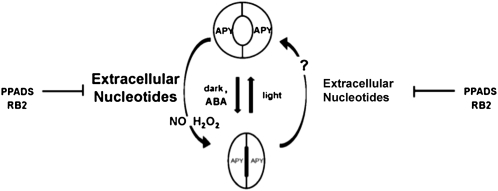Figure 10.
Model for the regulation of stomatal movements by extracellular nucleotides. Treatment with the nucleotides ATPγS and ADPβS at high concentrations (greater than 150–250 μm) induces stomatal closure and the release of NO and H2O2, whereas the addition of low concentrations of these nucleotides (15–35 μm) leads to the opening of stomata. These responses to either high (indicated by larger type) or low concentrations of nucleotides can be blocked by the mammalian purinoceptor inhibitors PPADS and RB2, which can also block the ability of ABA to induce stomatal closing and the ability of light to induce opening. The light treatment that induces stomatal opening also induces a higher expression of the transcripts and proteins of APY1 and APY2, and the text discusses the likelihood that these are ectoapyrases that would help regulate the concentrations of extracellular nucleotides during stomatal opening and closing.

